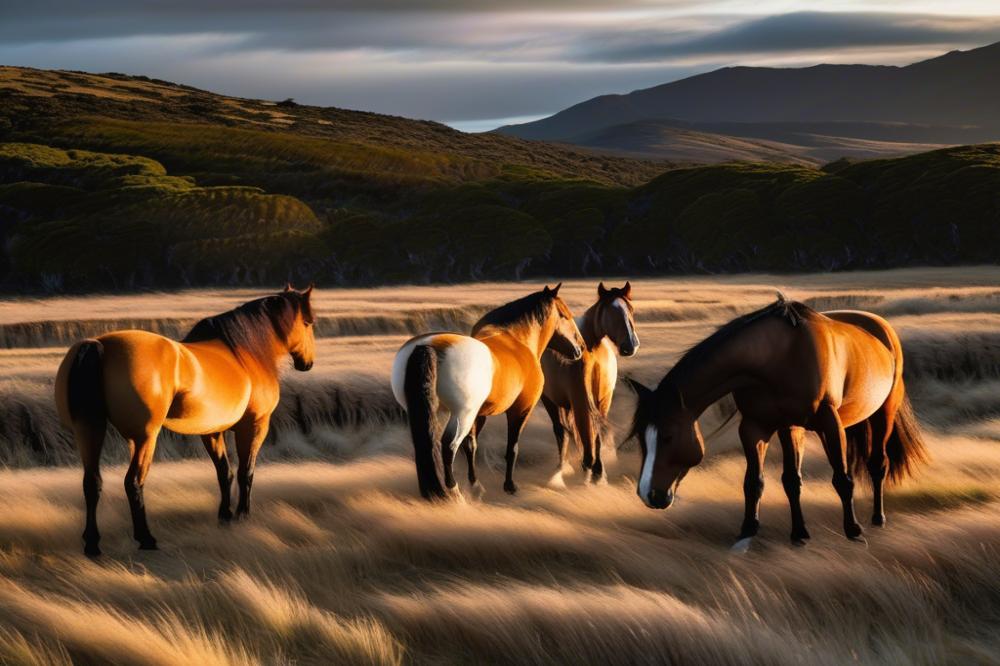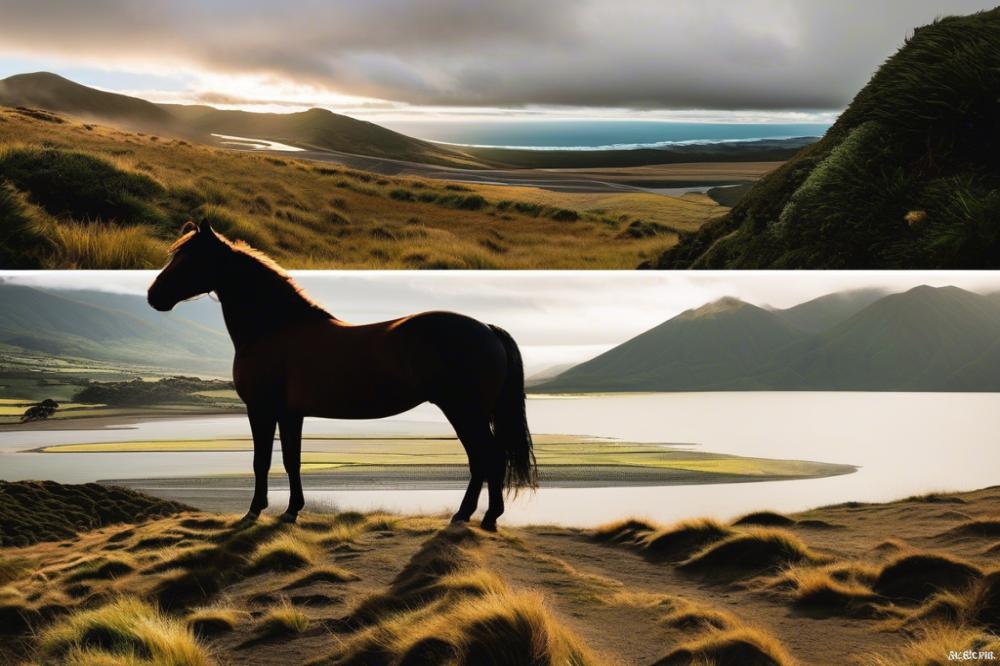Introduction
New Zealand is home to several feral horse populations that have captured the interest of many. Among these are the Kaimanawa Horses, a group that thrives in the rugged terrains of the North Island. These horses roam freely across the vast landscapes, embodying a spirit that reflects their unique environment. Understanding their behavior and survival is crucial for scientists and nature enthusiasts alike.
feral herds have a significant place in New Zealand‘s ecology. They contribute to the balance of their ecosystems and offer insights into wild horse dynamics. Observing these animals allows researchers to explore important questions about evolution, adaptation, and the impact of humans on animal populations.
Studying wild horse populations globally also sheds light on conservation efforts. It provides valuable lessons on how to manage and protect these majestic creatures. As society continues to face environmental challenges, learning from groups like the Kaimanawa Horses becomes ever more important. These horses are not just part of New Zealand’s cultural identity; they symbolize resilience and the wildness of nature.
The History and Origins of Kaimanawa Horses

The Kaimanawa horses have a fascinating history in New Zealand. These wild equines are descendants of domesticated horses released in the 19th century. Their roots trace back to early European settlers who brought horses to assist with farming and transportation. Over time, some of these animals escaped or were abandoned, leading to the formation of a feral population.
Genetic diversity plays a critical role in their survival. The herds consist of various breeds and bloodlines, contributing to their adaptability. Studies show that this diverse genetic makeup helps them thrive in the rugged landscapes of their native habitat. As with many wild populations, maintaining this diversity is essential for their health and resilience against environmental challenges.
Human actions have significantly affected the population of these horses. Historically, attempts to control their numbers have resulted in culling and relocation efforts. In some cases, these interventions aimed to reduce competition with livestock or protect native flora. Such measures often led to public outcry, highlighting a growing concern for animal welfare and conservation.
Located in the North Island, the Kaimanawa Desert serves as the primary habitat for these animals. This vast, arid region features an array of terrains, including grasslands, scrub, and rugged hills. Such an environment allows the horses to roam freely and find their own food and water sources. The relative isolation of the desert provides a safe space away from urban developments, creating a haven for the herds.
Ecological Role of Kaimanawa Horses

The influence of these wild horses on their environment is significant. They roam freely across the Kaimanawa Range, grazing on various plants and grasses. This grazing helps maintain the balance of the local ecosystem. However, their presence raises questions about the delicate relationships with other native species.
Interactions with native wildlife are complex. While horses consume large amounts of vegetation, this can open up space for new plants to grow. Certain birds and insects rely on these plants for food and shelter. Some argue that this grazing impacts the survival of specific native species, creating a ripple effect throughout the habitat.
Vegetation plays a vital role in the ecosystem. Without it, soil erosion could become a problem. Horses do not just eat; they also contribute to nutrient cycling. Their waste enriches the soil, providing nutrients that support new plant growth. This interaction can increase biodiversity in some areas.
However, not all effects are positive. Overgrazing can lead to bare patches in the landscape. This change can reduce habitat for ground-nesting birds and other creatures that depend on a thick cover of plants. The balance is crucial, and too many horses can disrupt it.
In summary, these wild animals play an intricate role within their habitat. Their impact shows both benefits and challenges. Keeping an eye on their populations is essential for preserving New Zealand’s rich biodiversity.
Horse Behavior and Social Structure
Understanding the social dynamics of Kaimanawa herds
Life in the wild can be tough for horses. Kaimanawa herds have complex social structures. A hierarchy often forms, determining who has priority for food and water. Within these groups, interactions dictate relationships. Some horses become leaders while others follow. The stronger members often protect the younger ones. This structure helps keep the herd cohesive in an often challenging environment.
Behavioral adaptations to the New Zealand environment
The landscape in New Zealand varies greatly. Horses adapt to these changes for survival. In more rugged areas, they learn to navigate difficult terrain efficiently. Foraging becomes crucial when food is scarce. This leads to behaviors such as group grazing, where horses work together to find sustenance. Playing and socializing also occur, helping to strengthen bonds among the herd. Such activities can lessen stress and build a stable environment for all members.
Reproductive patterns and breeding behaviors
Breeding happens primarily in spring. During this time, stallions may compete for the attention of mares. Rituals involve displays of strength and agility. A successful stallion often secures a harem of mares. Mothers show tight bonds with their foals, providing guidance and protection. Young horses learn essential skills by observing their parents. This teaching is vital for their future survival.
The importance of herd structure for survival
The organization of the herd plays a significant role in overall survival. Some members are more skilled at finding food, while others excel at noticing danger. By pooling their strengths, the herd increases its chances of survival. When threats arise, stronger horses may defend weaker ones. This collaboration enhances the safety of vulnerable animals, such as younger foals or older members. A tight-knit group fosters resilience against challenges, both environmental and social.
Conservation Efforts and Challenges
Current Conservation Strategies for Kaimanawa Horses
Conservation strategies are crucial for protecting New Zealand’s feral horses. Efforts include monitored population counts and habitat maintenance. Organizations aim to balance horse populations with native flora and fauna. Regular assessments help identify areas needing care. By focusing on sustainable practices, these initiatives seek to promote ecological harmony.
Role of Breeding Programs in Maintaining Population Health
Breeding programs play an essential role in sustaining horse health. These programs help to manage genetic diversity, which is vital for long-term survival. Keeping a close eye on breeding pairs can reduce the risk of inherited health issues. By selectively breeding for strength and adaptability, horses can thrive in their natural surroundings.
Challenges Faced in Equine Welfare and Habitat Preservation
Challenges abound in equine welfare and habitat preservation. Land development often threatens natural habitats. Additionally, competition for resources between horses and other wildlife is a significant issue. Overgrazing can lead to soil degradation, further stressing local ecosystems. These factors often complicate conservation efforts and can create unrest within communities.
Involvement of Local Communities and Organizations
Local communities play an integral part in conservation efforts. Many residents collaborate with organizations to protect these animals. Volunteers are essential for conducting surveys and maintaining trails. Education programs aim to raise awareness about the importance of preserving both equine and native species. Engagement in these activities often fosters a stronger connection between people and wildlife.
Kaimanawa Horses in the Future
The future of these wild horses appears promising, especially as a symbol of conservation. Many people are starting to recognize their role in New Zealand’s ecology. These horses embody the spirit of the wild, drawing attention to the importance of preserving native landscapes. They represent more than just a herd; they signify freedom and resilience in nature.
Tourism is growing around the Kaimanawa region. Visitors are keen to see these feral animals roaming freely in their natural habitat. This surge in public interest brings both challenges and opportunities. Local businesses benefit from increased tourism while also needing to protect the environment that attracts visitors. Striking a balance is crucial for both the horses and the surrounding ecosystems.
Population dynamics are shifting as well. Regular monitoring can shed light on health trends and breeding patterns. Changes in weather and land use impact their habitats, making conservation efforts necessary. Protecting their environment will require cooperation between government bodies and local communities. Community involvement can play a significant role in shaping the future of the horses and ensuring their survival.
People’s attitudes toward conservation are also evolving. More individuals are advocating for animal welfare, as awareness spreads about the issues faced by wild herds. This positive trend might lead to innovative conservation strategies that benefit both horses and their habitats. Increased collaboration among various stakeholders could lead to effective solutions. Fostering a deeper connection between the public and these animals can result in lasting support for conservation measures.
Final Thoughts on Kaimanawa Horses
The significance of Kaimanawa Horses cannot be overstated. These wild horses represent not just a part of New Zealand’s landscape but also its rich heritage. They embody a spirit of resilience, thriving in challenging environments. Their presence enriches the local ecosystem, providing a unique dynamic that supports biodiversity.
However, threats remain. Habitat loss and overpopulation continue to impact their survival. Efforts to raise awareness about their plight are crucial. Communities must get involved in conservation initiatives. Understanding the need to protect these horses is essential for their future. Every voice matters, and every action counts.
Globally, the status of these feral herds stands apart. Few populations exhibit such a fascinating blend of history, ecology, and human connection. While many countries face challenges with wild horses, the Kaimanawa Horses offer a hopeful narrative. Their story teaches us about the complex relationships between humans and nature.
As we look toward the future, protecting this herd is not just an option; it is a responsibility. Awareness and action are needed now more than ever. Together, we can help secure a brighter future for these remarkable creatures and preserve the legacy of New Zealand’s wild horses.



